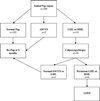Human papillomavirus prevalence, cervical abnormalities and risk factors among female sex workers in Lima, Peru
- PMID: 22581946
- PMCID: PMC4699584
- DOI: 10.1258/ijsa.2011.011193
Human papillomavirus prevalence, cervical abnormalities and risk factors among female sex workers in Lima, Peru
Abstract
Female sex workers (FSWs) are at high risk of human papillomavirus (HPV) infection. Questionnaires were administered to 200 FSWs aged 18-26 years in Lima, Peru, to gather risk behaviours, and cervical swab samples were collected for Pap smears and HPV DNA testing as part of a longitudinal study. Participants reported a median of 120 clients in the past month, and 99.2% reported using condoms with clients. The prevalence of any HPV in cervical samples was 66.8%; 34 (17.1%) participants had prevalent HPV 16 or 18, and 92 (46.2%) had one or more oncogenic types. Fifteen women had abnormal Pap smears, 13 of which were HPV DNA positive. Fewer years since first sex was associated with oncogenic HPV prevalence in a model adjusted for previous sexually transmitted infection (STI) status and condom use with partners (prevalence ratio = 0.77, 95% confidence interval [CI] = 0.60-0.97). Our data confirm the high rates of HPV transmission among FSWs in Peru, highlighting the need for early and effective strategies to prevent cervical cancer.
Figures



Similar articles
-
Human papillomavirus infection among male clients of female sex workers soliciting sex in brothels in Peru.Int J STD AIDS. 2018 Feb;29(2):178-184. doi: 10.1177/0956462417721563. Epub 2017 Jul 26. Int J STD AIDS. 2018. PMID: 28747145 Free PMC article.
-
Oral sex practices, oral human papillomavirus and correlations between oral and cervical human papillomavirus prevalence among female sex workers in Lima, Peru.Int J STD AIDS. 2011 Nov;22(11):655-8. doi: 10.1258/ijsa.2011.010541. Int J STD AIDS. 2011. PMID: 22096051 Free PMC article.
-
Prevalence of high-risk human papillomavirus and abnormal pap smears in female sex workers compared to the general population in Antwerp, Belgium.BMC Public Health. 2016 Jun 7;16:477. doi: 10.1186/s12889-016-3099-5. BMC Public Health. 2016. PMID: 27266509 Free PMC article.
-
Molecular pathogenesis of cervical cancer.Cancer Biol Ther. 2011 Feb 1;11(3):295-306. doi: 10.4161/cbt.11.3.14686. Epub 2011 Feb 1. Cancer Biol Ther. 2011. PMID: 21239888 Review.
-
Oncogenic potential of Human Papillomavirus (HPV) and its relation with cervical cancer.Virol J. 2011 Jun 3;8:269. doi: 10.1186/1743-422X-8-269. Virol J. 2011. PMID: 21635792 Free PMC article. Review.
Cited by
-
Factors associated with uptake and acceptability of cervical cancer screening among female sex workers in Northeastern Uganda: A cross-sectional study.PLoS One. 2025 Jan 24;20(1):e0312988. doi: 10.1371/journal.pone.0312988. eCollection 2025. PLoS One. 2025. PMID: 39854583 Free PMC article.
-
Human papillomavirus infection among male clients of female sex workers soliciting sex in brothels in Peru.Int J STD AIDS. 2018 Feb;29(2):178-184. doi: 10.1177/0956462417721563. Epub 2017 Jul 26. Int J STD AIDS. 2018. PMID: 28747145 Free PMC article.
-
Association between human papillomavirus and human T-lymphotropic virus in indigenous women from the Peruvian Amazon.PLoS One. 2012;7(8):e44240. doi: 10.1371/journal.pone.0044240. Epub 2012 Aug 29. PLoS One. 2012. PMID: 22952937 Free PMC article.
-
Barriers to Follow-Up for Abnormal Papanicolaou Smears among Female Sex Workers in Lima, Peru.PLoS One. 2017 Jan 6;12(1):e0169327. doi: 10.1371/journal.pone.0169327. eCollection 2017. PLoS One. 2017. PMID: 28060937 Free PMC article.
-
High HPV prevalence and need for ancillary care.Braz J Infect Dis. 2015 Jan-Feb;19(1):110. doi: 10.1016/j.bjid.2014.09.003. Epub 2014 Dec 15. Braz J Infect Dis. 2015. PMID: 25523078 Free PMC article. No abstract available.
References
-
- WHO International Agency for Research on Cancer. IARC, Monographs on the Evaluation of Carcinogenic Risks to Humans: Human Papillomaviruses. Vol. 90. Lyon: International Agency for Research on Cancer; 2007.
-
- Bruni L, Diaz M, Castellsague X, Ferrer E, Bosch FX, de Sanjose S. Cervical human papillomavirus prevalence in 5 continents: meta-analysis of 1 million women with normal cytological findings. J Infect Dis. 2010;202:1789–1799. - PubMed
-
- de Sanjosé S, Diaz M, Castellsagué X, et al. Worldwide prevalence and genotype distribution of cervical human papillomavirus DNA in women with normal cytology: a meta-analysis. Lancet Infect Dis. 2007;7:453–459. - PubMed
-
- Ferlay J, Shin HR, Bray F, et al. Cancer incidence and mortality worldwide: IARC Cancer Base, No. 1. Lyon: International Agency for Research on Cancer; 2010. [last accessed 13 February 2012]. GLOBOCAN 2008 v1.2. Available from: http://globocan.iarc.fr.
-
- Calhoun B. Feasibility of a Community-based Voluntary HIV Counseling and Testing Program in Commercial Sex Venues in Lima, Peru. Washington: Third Annual Poster Presentation at Puget Sound Partners for Global Health Lecture, Puget Sound; 2005.
Publication types
MeSH terms
Substances
Grants and funding
LinkOut - more resources
Full Text Sources
Medical
Research Materials
Miscellaneous

